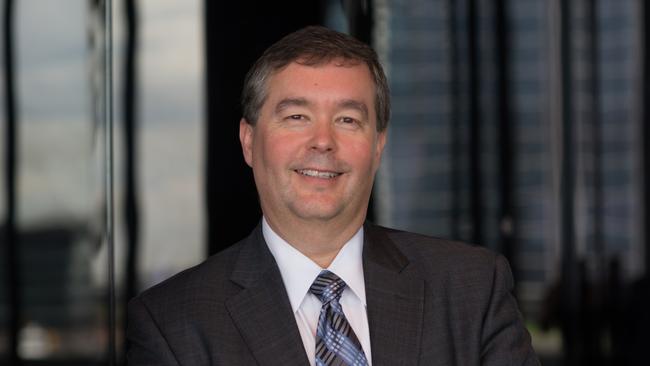Westpac says it’s very confident of a $3bn tech revamp by end of 2027
Westpac’s multi-billion dollar technology restructure is ‘very doable’ by the end of 2027 and its completion is not contingent on the current management team, CIO Scott Collary says.

Westpac’s $3bn technology restructure should be “very doable” by the end of 2027 and its completion is not contingent on the current management team, chief information officer Scott Collary said.
Speaking ahead of its technology simplification market update, Mr Collary told The Australian the roughly 2500 staff working in its huge program of work were “excited” about finally having a single “modular” system for all of its six brands.
“That’s going to make it easier for customers to do business with us, easier for our bankers to do business, helps us take cost out and bring our efficiency ratio in line with our peer group a little bit better,” Mr Collary said.
A set of complicated processes, policies and underlying technology applications servicing Westpac, St. George, Bank of Melbourne, BankSA, BT and RAMS will finally be standardised by business lines, which the bank calls “domains”.
The project, dubbed “Unite”, was flagged by the bank last November and has already started. A set of about 180 “groupings or categories of work” Westpac bankers currently handle will shrink to just 60.

On Wednesday, Westpac detailed its total technology investment spend to be about $1.8bn this financial year and then $2bn annually from FY25 to FY28.
Analysts have been sceptical of Westpac’s plans to finally integrate duplicated St George systems – more than 15 years after its 2008 acquisition – and were quick to downgrade their earnings expectations when the bank flagged the IT restructure late last year.
Veteran banking analyst Brian Johnson earlier this month said execution risks from the project could push costs much higher than currently expected. He highlighted uncertainty about the management team that would be responsible for delivering the project.
That was after The Australian reported Westpac chairman Steven Gregg had flagged, in discussions with some analysts and investors, that the board was actively looking to replace chief executive Peter King by the end of the year.
When asked at a conference on Tuesday about the reports, Mr King discounted them as “speculation”.
“Papers love speculation on CEO succession. The bad news is there’s no news today. For me, what’s this all about? Well, I’ve run a great company. It’s Australia’s oldest (bank),” he said.
“We’ve done our portfolio simplification, and we’re really focused on getting our service right for customers. That’s what I’m very much focused on.”
Mr King said he was proud of the stabilisation he had brought to the bank when he started as CEO in 2019, and about the work he had led to simplify Westpac and boost its risk and regulatory systems.
Because of that work, the bank was now ready to focus on simplifying its “offers to customers and help bankers do that – and technology will be a big part of that,” he said.
Mr Collary said the Unite program had the full support of the Westpac board and was therefore not reliant on any particular management leadership team.
“The board asked us how we can accelerate this (technology simplification) and Unite is the program that we came back with, so they are right behind it. Our new chair is very supportive. He is behind the program,” Mr Collary said.
Mr King was also “behind it, encouraging and very supportive” and the plans were “generating a lot of excitement across the company,“ he said.
While Unite is a major priority for Westpac, the bank said the project would not represent the entire $2bn annual technology budget on its own.
Instead, its costs are being absorbed as part of its planned IT investment for the coming years, which also includes maintenance work, regulatory and risk expenses. Westpac investment expenditure averaged $1.3bn per year during the five years prior to 2019, and $1.9bn since then.
The Sydney-based lender has moved from a previous $8bn, and then $8.6bn, cost target, to a current aim to have a cost to income ratio “comparable” to peers.
The Unite project started last year and will continue over the next four years, Mr Collary said. In total there were 85 defined “initiatives” that will be sequenced and worked through methodically over that period.
About 11 of those initiatives, involving mostly planning, had taken place and the bank would start another 6 in the second half of 2024.
“The heavy lifting will be 2025, 2026, early 2027. And then you’ll start to see more focus on just turning things off, decommissioning and getting the last mile out of the work”, Mr Collary said.
Legacy systems would be broken into modular components to allow faster adaptation to new technologies, he said.
Asked whether the timeline should be seen as conservative or ambitious, he said it was “a very doable timeline”.
“We have 85 initiatives mapped out, so we have some degree of confidence in that. Four years is a period of time where things will change, so we may move one thing faster, another slower. So there’s some dynamic flexibility there, but those 85 we feel pretty confident in it.”
The bank is using generative AI to speed up coding for the modules it is building. That technology was helping boost the productivity of development teams by about 30 per cent.




To join the conversation, please log in. Don't have an account? Register
Join the conversation, you are commenting as Logout